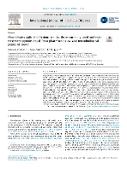Clostridioides difficile infection: are the three currently used antibiotic treatment options equal from pharmacological and microbiological points of view?

Publication date
2022Published in
International Journal of Infectious DiseasesVolume / Issue
124 (November)ISBN / ISSN
ISSN: 1201-9712Metadata
Show full item recordCollections
This publication has a published version with DOI 10.1016/j.ijid.2022.09.013
Abstract
Recently, the recommendations for the treatment of Clostridioides difficile infection (CDI) have been updated. However, in addition to the clinical efficacy data, the drug of choice should ideally represent optimal antimicrobial stewardship, with an emphasis on rapid restoration of the gut microbiota to minimise the risk of infection relapses. Oral administration of metronidazole results in low concentration in stool and interaction with faecal microbiota reduces its antimicrobial bioactivity. Reported elevated minimum inhibitory concentrations of metronidazole in epidemic C. difficile ribotypes and the emergence of plasmid-mediated resistance to metronidazole represent additional potential risks for clinical failure. If metronidazole is the only CDI treatment option, antimicrobial susceptibility testing on agar containing haem should be performed in C. difficile isolate. Compared to metronidazole, oral vancomycin and fidaxomicin reach very high concentrations in the stool, and therefore, have the ability to quickly reduce C. difficile shedding. Healthcare facilities with higher CDI incidence and/or occurrence of epidemic ribotypes should not use metronidazole because prolonged C. difficile shedding can increase the risk for further C. difficile transmission. Only fidaxomicin has a narrow spectrum of antimicrobial activity, which might be together with persistence on spores the main contributing factors to reducing of recurrent CDI rates.
Keywords
Clostridioides difficile infection, antimicrobial activity, fidaxomicin, metronidazole, resistance, spores, susceptibility testing, vancomycin
Permanent link
https://hdl.handle.net/20.500.14178/1650License
Full text of this result is licensed under: Creative Commons Uveďte původ 4.0 International







